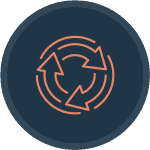Creating safer, more effective and engaging experiences for your customers starts much earlier.
The foundation for great products begins with exploratory research and spans the entire development process.
Explore & understand

Understand the challenges faced by patients, caregivers, and healthcare professionals when interacting with similar products already on the market.
- We observe intended users of your product in their natural use environments. This helps inform definitions of critical tasks, as well as, provide a better understanding early on for which use-related challenges and risks your product should account.
- We analyze behavioral data, qualitative feedback, and existing post-market surveillance data to get a comprehensive understanding of barriers to safe and effective use.
- We inform the development of a robust human factors plan that will minimize the amount of time and effort required to validate your product.
Design & iterate

Get feedback early and often to fix use-related risks while it’s still easy to do so.
- Rapidly test early design iterations in small sample formative usability tests to mitigate use-related risks.
- Document updates to the use-related risk analysis (URRA) and progress the HFE report to reflect the evolution of your product’s design as a result of formative evaluations.
- Refine and finalize definitions for intended users, use environments, and (critical) tasks.
- As product design approaches production equivalence, shift focus to refinement of research protocols and simulation of use environments in preparation for human factors validation.
Measure & validate

Know where you stand and get the insight you need to focus future development efforts or to document the achievement of objectives.
- Ensure that intended users, critical tasks, and elements of simulated use are appropriately defined.
- Conduct thorough root cause analysis of all observed use errors, close calls and operational difficulties to determine if residual use-related risk is acceptable.
- Validate that your product can be used safely and effectively by its intended users, in its intended use environments, for its intended uses
Management & strategy

It happens that organizations do not have proper medical device development processes in place (because there is rarely need for it) or the organization is large and processes vary from department to department. We support you in getting the task done.
- We provide consulting and interim management to set up one-time medical device developments according to regulatory needs.
- We analyze existing processes (or create them). We align them to be more efficient and at the same time fulfill all regulatory requirements.
- We connect you to international partners worldwide and execute your studies where you don’t have boots on the ground.
Contact information
uintent
Web: www.uintent.com
Email: hello@uintent.com